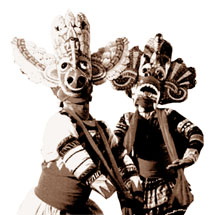
Dances with masks
Sri Lanka has a rich culture. In our last 'Heritage Splendour' pages,
we spoke about Sri Lanka's traditional drums and dancing. Today, we will
tell you about the masks of Sri Lanka, another attraction of the
country.
Mask production is mainly centred in and around Ambalangoda, on the
southern coast. In our olden days, people used to worship demons or
yakku, as they were called in Sinhala.
Today, the tradition of hanging a mask upon new houses and huts is
seen almost everywhere, to prevent evil spirits entering the place,
especially while it's under construction.

Also, in earlier times, when a person fell sick and wasn't cured by
medicines, the people came to the conclusion that the disease was caused
by a demon, so they organised a 'Thovil'.
This is not very common now. During a Thovil, masks are heavily used
to depict the demon. It always connects with traditional dancing. In
other words, masks are used in various dramatic rituals in Sri Lanka
which can be classified as mythological, demonic, animal-spirit and
human figures.
The significance and designs of mythological masks are associated
with iconography (depicting something in pictures) of the folk religions
of the historical period. On the other hand, the significance and design
of the human masks have evolved in recent times.
The real masks and masking traditions are extraordinary cultural
events and a significant contribution that Sri Lanka has made to the
Asian cultural spectrum.

The present-day indigenous people, who are considered to be the
primeval (earliest) ancestors of the Sinhalese, have preserved various
ritual ceremonies and practices involving mime (acting with gestures),
facial (expressions) and body painting.
Some of these practices are directly connected with ancestor worship
as is evident from the na-Yaku cult. These attempts at praying to the
supernatural are evident in other parts of the world too where
hunter-gatherer societies still exist.
Masks exist basically in three contexts in the ritual, in the
ceremonial dance, professional displays and festive occasions.
The curative rituals are commonly known as thovil, and include Sanni/Daha
ata sanni, in which masks are extensively used: rituals associated with
gods are known as Gammadu and Devol madu where a pantheon of divinity
are invoked either to bring prosperity or to chase away infectious
diseases, where masked dances are few and far between.

There exist two other demon dance ceremonies called Mahasohon
Samayama and Gara-yakuma, the former is connected with the belief in a
ghastly and hairy monster of gigantic proportion, called Mahasohona, the
demon of the graveyard, while the latter is associated with a group of
demons referred to as Garayakku.
In mask practices, the most important of the thovil varieties is the
cycle known as Sanni where disease-causing demons are symbolised through
masks. But the most elaborate masks are of the kolam variety. Naga masks
are also some of them.
They comprise very elaborate designs featuring a demonic face topped
with writhing cobras. It is said to represent protection. Its
counterpart is the gurulu mask, featuring a snake eating bird.
These events are more like an opera, having a central theme and a
series of episodes enacted by dancers wearing masks of different sizes,
culminating in the dramatic presentation of a story (Jasaya and Lenchina).
Sanni means an ailment or disease.
These are believed to arise out of the dark states of the humours-evil
humour and anger which are caused by a set of demons, each of them
called Sanni-yaka, but in his birth story is called Raja-mulu Sanni yaka.
The sanni masks except that of the chief demon belong to a variety
commonly known as kata munu and belong to a similar variety.
In a sanni ceremony, there are two types of masks; sanni masks and
Pali masks. If sicknesses are to be cured, the rituals can last all
night. A sanni mask is worn which includes ugly representations of 18
different devils associated with afflictions. The ritual is to drive
them out. Eighteen separate masks can be used in these ceremonies.
This is also more like a theatre. Since there is much dialogue in the
various scenes, the sanni masks are carved with adequate provision for
the mask-wearer to talk at length and have his voice heard loud and
clear by the audience.
The masks of Sri Lanka is a very fascinating subject. We hope to
share more details about them with you in future.
Janani Amarasekara |


